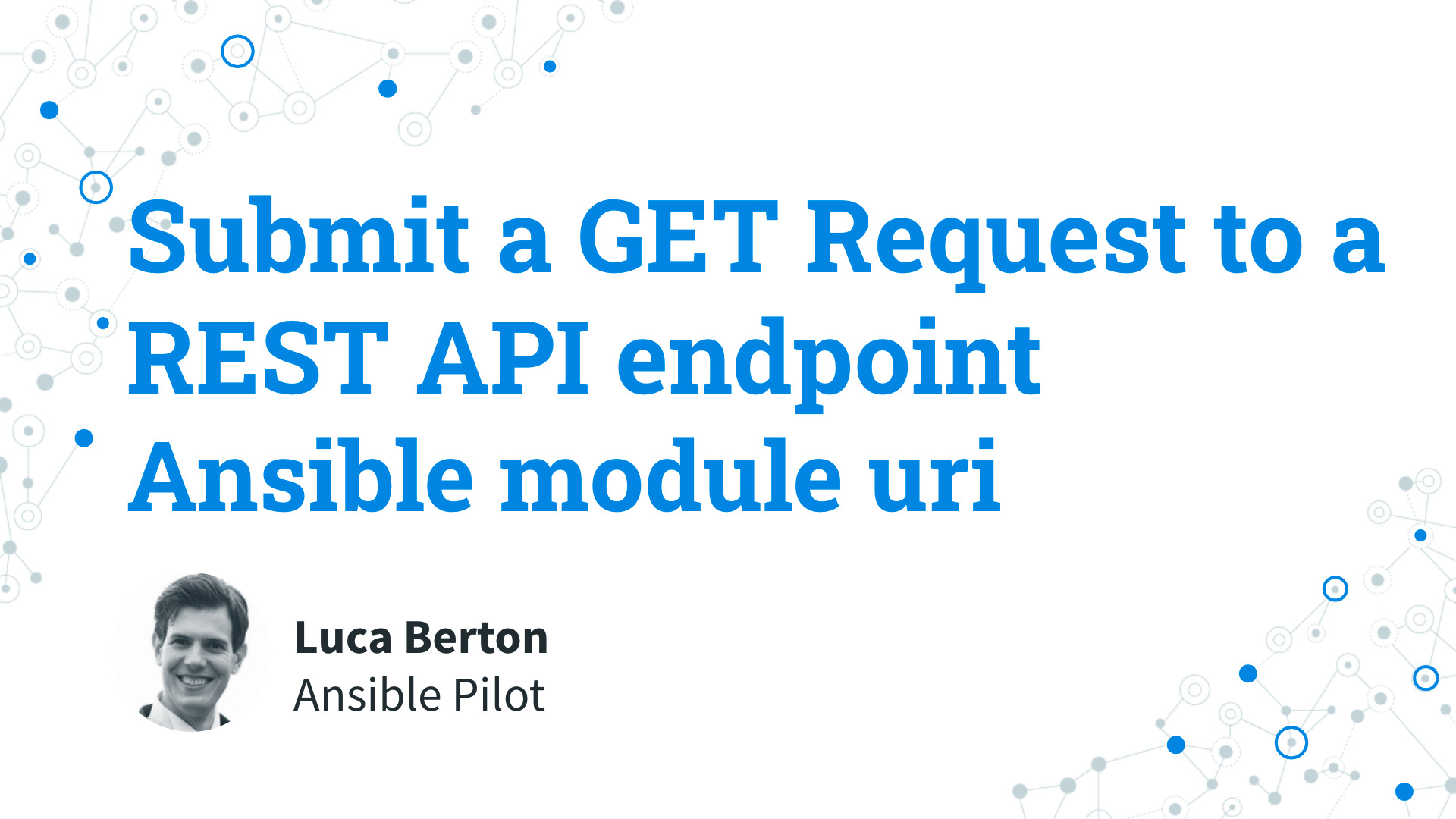How to submit a GET request to a REST API endpoint with Ansible?
I’m going to show you a live Playbook and some simple Ansible code. I’m Luca Berton and welcome to today’s episode of Ansible Pilot.
Ansible submits a GET request to a REST API endpoint
- ansible.builtin.uri
- Interacts with web services supports Digest, Basic, and WSSE HTTP authentication mechanisms
Today we’re talking about Ansible module uri.
The full name is ansible.builtin.uri, which means that is part of the collection of modules “builtin” with ansible and shipped with it.
It’s a module pretty stable and out for years and it works in a different variety of POSIX operating systems.
It interacts with web services and supports Digest, Basic, and WSSE HTTP authentication mechanisms.
If you need to download content, use the Ansible ansible.builtin.get_url module.
For Windows targets, use the ansible.windows.win_uri module instead.
Parameters
- url string - (http|https)://host.domain[:port]/path
- method string - “GET”, “POST”, “PUT”, “PATCH”, “DELETE”
- user (url_username), password (url_password) string - username, password credentials
- force_basic_auth boolean - no,yes - Basic authentication header
- status_code list/integer - [200, 202]
- headers dictionary - custom HTTP headers, Content-Type
- body_format string - raw, json,
form-urlencoded,form-multipart - body raw - request body
- return_content boolean - no/yes - return the body of the response
- timeout integer - 30 seconds
This module has some parameters to perform any tasks.
The only required is “url”, where you specify the API URL.
The parameter “method” specifies the HTTP method of the request: “GET”, “POST”, “PUT”, “PATCH”, “DELETE”.
The parameters “user” and “password” specify the credentials to access the API. Several authentications methods are supported, for the simplest is the Basic HTTP authentication remember to enable the “force_basic_auth” boolean.
The parameter “status_code” sets the expected single or list of expected HTTP status codes. The most commons are okay is 200, not fount is 404, and so on… If Please note that Ansible is going to return an error if the status code is different.
The parameter “headers” set the custom HTTP headers and HTTP Content-Type.
The parameter “body_format” sets the serialization format of the body content. Default is raw, but you could customize it to send an image for example. There are some restrictions with Content-Type and some serializations.
The parameter “return_content” is very important to return the body of the response as a “content” key in the dictionary result.
The default timeout is set to 30 seconds, but you could customize it with the “timeout” parameter.
Links
- https://reqres.in/
- https://reqres.in/api/users?page=2
- https://docs.ansible.com/ansible/latest/collections/ansible/builtin/uri_module.html

Playbook
Let’s jump into a real-life playbook on how to submit a GET request to a REST API endpoint with Ansible.
code
- get_list_users.yml
---
- name: uri module Playbook
hosts: all
become: false
vars:
server: "https://reqres.in"
endpoint: "/api/users?page=2"
tasks:
- name: list users
ansible.builtin.uri:
url: "{{ server }}{{ endpoint }}"
method: GET
status_code: 200
timeout: 30
register: result
- name: debug
ansible.builtin.debug:
var: result.json.data
API
browser result (https://reqres.in/api/users?page=2):
{"page":2,"per_page":6,"total":12,"total_pages":2,"data":[{"id":7,"email":"[email protected]","first_name":"Michael","last_name":"Lawson","avatar":"https://reqres.in/img/faces/7-image.jpg"},{"id":8,"email":"[email protected]","first_name":"Lindsay","last_name":"Ferguson","avatar":"https://reqres.in/img/faces/8-image.jpg"},{"id":9,"email":"[email protected]","first_name":"Tobias","last_name":"Funke","avatar":"https://reqres.in/img/faces/9-image.jpg"},{"id":10,"email":"[email protected]","first_name":"Byron","last_name":"Fields","avatar":"https://reqres.in/img/faces/10-image.jpg"},{"id":11,"email":"[email protected]","first_name":"George","last_name":"Edwards","avatar":"https://reqres.in/img/faces/11-image.jpg"},{"id":12,"email":"[email protected]","first_name":"Rachel","last_name":"Howell","avatar":"https://reqres.in/img/faces/12-image.jpg"}],"support":{"url":"https://reqres.in/#support-heading","text":"To keep ReqRes free, contributions towards server costs are appreciated!"}}
execution
$ ansible-playbook -i virtualmachines/demo/inventory interract\ webservices/list_users.yml
PLAY [uri module Playbook] ****************************************************************************
TASK [Gathering Facts] ****************************************************************************
ok: [demo.example.com]
TASK [list users] *********************************************************************************
ok: [demo.example.com]
TASK [debug] **************************************************************************************
ok: [demo.example.com] => {
"result.json.data": [
{
"avatar": "https://reqres.in/img/faces/7-image.jpg",
"email": "[email protected]",
"first_name": "Michael",
"id": 7,
"last_name": "Lawson"
},
{
"avatar": "https://reqres.in/img/faces/8-image.jpg",
"email": "[email protected]",
"first_name": "Lindsay",
"id": 8,
"last_name": "Ferguson"
},
{
"avatar": "https://reqres.in/img/faces/9-image.jpg",
"email": "[email protected]",
"first_name": "Tobias",
"id": 9,
"last_name": "Funke"
},
{
"avatar": "https://reqres.in/img/faces/10-image.jpg",
"email": "[email protected]",
"first_name": "Byron",
"id": 10,
"last_name": "Fields"
},
{
"avatar": "https://reqres.in/img/faces/11-image.jpg",
"email": "[email protected]",
"first_name": "George",
"id": 11,
"last_name": "Edwards"
},
{
"avatar": "https://reqres.in/img/faces/12-image.jpg",
"email": "[email protected]",
"first_name": "Rachel",
"id": 12,
"last_name": "Howell"
}
]
}
Conclusion
Now you know how to submit a GET request to a REST API endpoint with Ansible. Subscribe to the YouTube channel, Medium, and Website, X (formerly Twitter) to not miss the next episode of the Ansible Pilot.
Academy
Learn the Ansible automation technology with some real-life examples in my
Udemy 300+ Lessons Video Course.

My book Ansible By Examples: 200+ Automation Examples For Linux and Windows System Administrator and DevOps

Donate
Want to keep this project going? Please donate
